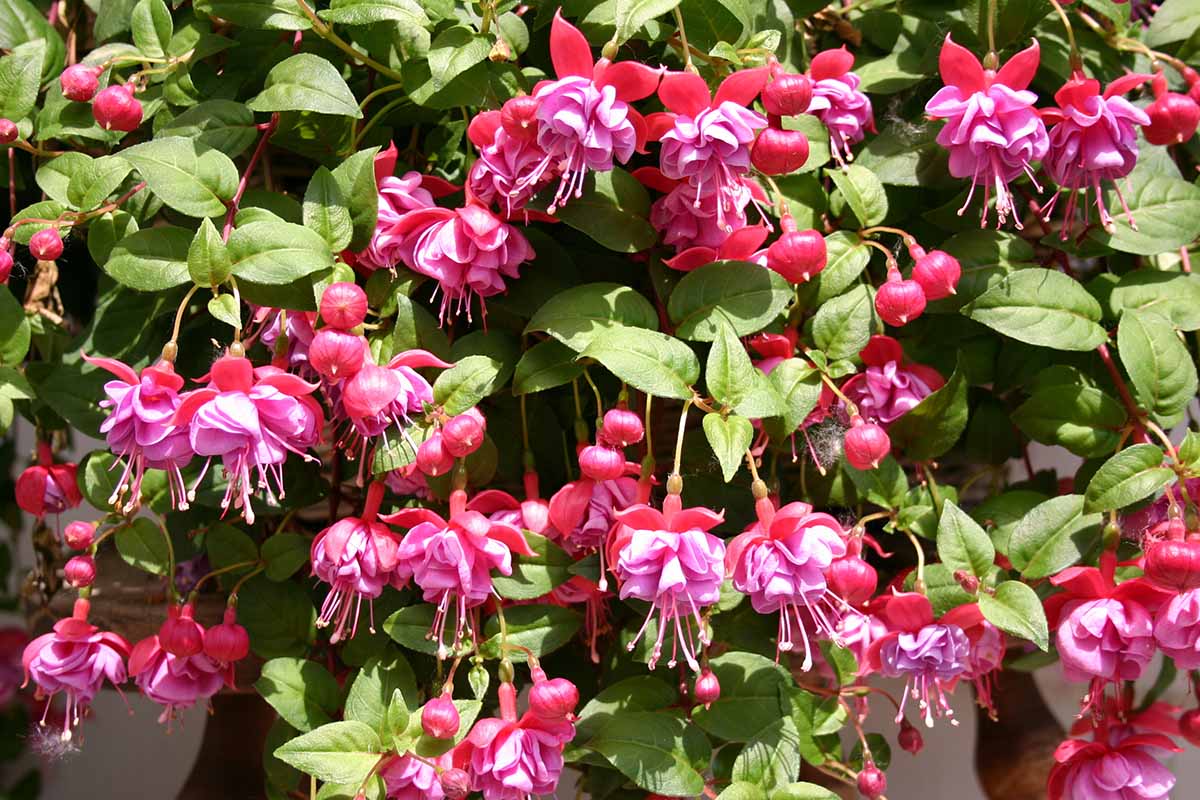
Who knew a microscopic pest could do so much damage? I guess anyone who has ever had a serious case of the flu understands how tiny pathogens can cause problems, but that doesn’t make it any less frustrating.
As gardeners, we often expect plant pests to be obvious, but fuchsia gall mites are invisible to the naked eye. You’d need a microscope to see them.
However, the damage they do is far from small. These pests can take your fuchsia from a big, lush, floriferous beauty to a funky, scraggly mess in no time flat.

We link to vendors to help you find relevant products. If you buy from one of our links, we may earn a commission.
If they’re invisible, how do you even know your fuchsia has an infestation? And what can you do about it if you confirm their presence? That’s what this guide aims to explain.
We’ll help you understand the nature of this pest, how to identify the symptoms they cause, and what to do about it. Here’s what you can expect:
Alas, identifying these pests isn’t going to be totally straightforward. To give you a leg up, let’s learn a bit about these tiny troublemakers.
About Gall Mites
Fuchsia gall mites (Aculops fuchsiae) are microscopic eriophyid mites that draw the sap out of plants using their sucking mouthparts.
The good news is they only attack species in the Fuchsia genus. The bad news is they attack all species in the genus.

You can’t see them with the naked eye because the adults are just 0.20 to 0.25 millimeters long. You’d need a 40x strength microscope to be able to make them out.
These mites have four life stages: egg, larvae, nymph, and adult.
Once temperatures reach about 64°F and remain there for several days, the eggs hatch about a week after being laid, and the entire life cycle is completed in about 21 days.
That means there is lots of time for populations to build up during the warm months. Then, all stages can overwinter in the plant, waiting for their chance to burst forth again the following spring.
The pests aren’t typically found in greenhouses, as they generally prefer cool temperatures.
But conversely, they don’t survive in low temperatures, either. In other words, fuchsia gall mites do best in the same sort of environment that fuchsias prefer.
The mites can travel on wind or hitch a ride on hummingbirds and bees as they visit the flowers. Gardeners spread them on contaminated tools or clothing.
When they find a host, the adults move into the plant’s hairs and the folds of existing galls to live, feed, and reproduce.
Range
These pests were first identified in 1971 in Brazil where lots of Fuchsia species grow indigenously.
They reached North America and were discovered in San Francisco county in 1983, completely decimating the fuchsia industry in the state, spreading quickly along the cool coast and more slowly into the warmer inland areas.

They then made their way to Oregon, Washington, Florida, and Hawaii, primarily infesting plants growing in cool, coastal areas.
The mites bounced across the globe to Europe after likely hitching a ride on plants and were first identified in France in 2002.
In 2007, growers were devastated to learn that the pests had arrived in mainland UK.
These days, wherever fuchsias thrive in South or North America, or Europe, gall mites are sure to be found.
Symptoms
As the pests feed on the plant’s cells, they secrete a poison, which causes new growth to be distorted and misshapen.
Look for disfigured growth tips, flowers, and leaves, as well as galls. Hairy growth is also common.

An infestation of aphids can also cause disfigured growth, so don’t immediately assume the presence of twisted leaves, gnarled stems, or stunted tips is a sure sign of mites.
Other symptoms include red or silvery-white discoloration on the stems and foliage. Western flower thrips (Frankliniella occidentallis) can also cause distorted, crinkled leaves and silvery coloration that can be confused with the symptoms of gall mites.
The presence of swollen galls on the stems is a more reliable indicator of the presence of these pests
But if you see any of these symptoms, I’d recommend you take a cutting of symptomatic plant tissue, place it in a sealed bag, and show it to your local extension office or fuchsia society.
Experts there can confirm the presence of mites.
Prevention
Before you bring any cutting or new plant into your garden or home, examine it thoroughly for any signs of pests and quarantine it for at least a month to watch for developing symptoms. Only buy from reputable sources, if you can.

Since the mites can travel on hummingbirds, bees, butterflies, pests, or gardening tools, even these steps don’t guarantee your plants will be safe.
The pests might find their way to your fuchsias.
Always, always clean your tools between uses to be extra safe.
You can wipe your tools in isopropyl alcohol, a 10 percent bleach mixture, or clean them in hot, soapy water to remove any hitchhikers.
Speaking of tools, use your pruners in the early spring or fall to trim woody fuchsia species back to bare wood and tender species back to the ground. Spray the remaining plant material with dormant oil to smother any exposed mites.
Brazilian Fuchsia species have developed some immunity, so consider growing these if you have had trouble with gall mites in the past. F. magellanica, M. coccinea, F. bracelinae, F. regia, F. campos-portoi, F. glazioviana, and F. alpestris are all good options.
Keep in mind that F. magellanica cultivars have been bred outside of Brazil for decades, so only those that come from Brazil in the past few decades will have built up immunity in their native region.
F. splendens, F. paniculata, and F. brevilobis are immune.
The Northwest Fuchsia Society lists ‘Carnival,’ ‘First Success,’ Lechlade Gorgon,’ ‘President Walter Mario,’ ‘Space Shuttle,’ and ‘Tangerine’ as immune.
‘Baby Two Step,’ ‘Bell Buoy,’ ‘Chickadee,’ ‘Golden Anne,’ ‘Jamboree,’ ‘Lena,’ ‘Miracle,’ ‘Mood Indigo,’ ‘Pink Jade,’ ‘Purple Rain,’ ‘Southgate,’ and ‘White King’ are resistant.
Just because a species or cultivar is resistant and immune doesn’t mean that the mites won’t feed on your plants, it’s just that the plants won’t become symptomatic.
Your plants can still be infested and you’ll still need to diligently watch for symptoms on other fuchsias nearby.
Control
As of yet, there isn’t a chemical control that works reliably to eliminate these pests.
The best method of control is to prune off any symptomatic branches and dispose of those in the garbage.
Prune back herbaceous fuchsias to the ground and heavily prune woody plants to bare wood in the fall.

Keep up on this pruning routine as long as the plant shows symptoms.
If you have a plant that is heavily symptomatic, it might be best to toss it in the garbage. Don’t compost infested plant material. If you want to try and save the plant, isolate it from other fuchsias while you work.
To control the infection, trim off all symptomatic parts and wait until the winter when the plant is dormant.
Spray it with a product that contains carbaryl, a dormant oil, or an oil that targets mites such as Bonide’s Mite-X.
Completely saturate the plant to kill all the mites and avoid allowing some to survive and build up immunity to the product.
Spray again after seven days and then again in another seven days. Repeat as long as the plant shows no signs of damage from the spray, such as yellowing leaves or wilting.
You can find Bonide Mite-X at Arbico Organics in 12-ounce or quart-sized ready-to-use containers.
Frequent spraying and heavy saturation is vital, because these pests hide in protected spots on the plant where chemical sprays often can’t reach them.
Keep the plant isolated and monitor it through the next growing season. You need to start your spraying routine again at the first sign of symptoms.
If your neighbor has untreated plants, it’s highly likely that the fuchsia gall mites will find those and eventually end up back on your plant at some point. In all honesty, if you have mites in your area, the chances are extremely high that your plants will be infested at some point.
Now, if you want to ensure your plants survive, pruning and spraying is the way to go, but I like to play with fire. Or, rather, ice – cold weather kills these pests.
If tender fuchsias are exposed to extremely cold temperatures, they will die. If the mites are exposed to temperatures around 21°F for a few days, they die.
This temperature is generally considered far too low for tender types, though most hardy fuchsia varieties are just fine.

I have left my infested tender fuchsias out in these temperatures figuring I have nothing to lose since they’re already infested. I lost one plant, but the other three survived and haven’t shown symptoms since.
There’s precedence for this method of control. After a few warm winters in the Pacific Northwest, fuchsia plants were being widely infected as of 2005.
But in 2006, there was an extremely cold winter, and those previously infested plants no longer had any damage during the next growing season.
If you can, leave your hardy fuchsias outdoors and let the cold weather kill off the pests.
You can also gamble like I do with your tender fuchsias, but just be aware that the chances are high that you’ll lose them, depending on the species or specific cultivar or hybrid.
But you might lose them to mites, anyway, if they don’t respond to treatment. It’s worth a try if you’re planning to throwing the plant out anyway.
At the very least, we now know that a series of cold winters will greatly reduce gall mite populations, while a few years of warm winters will cause populations to rebound.
While they haven’t yet been proven useful in the field, predaceous mites like Amblyseius californicus show promise in helping to control these pests.
Knowledge is Mightier Than Fuchsia Gall Mites
Fuchsia gall mites are here to stay, at least until some genius scientist comes up with a way to control them.

Until then, knowledge is power. Knowing what to watch for and how to take action if mites do arrive will make the difference between losing your plants and them living to fight another day.
Have you dealt with gall mites before? Or do you suspect that they’ve made their way into your garden? Let us know what you’re going through and if we can help with identification or control in the comments section below.
I truly hope this guide helped you avoid trouble or bring your plants back to health. If so, you might want more information about how to care for fuchsias. Check these out next:







